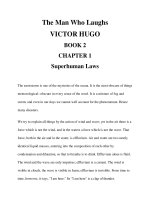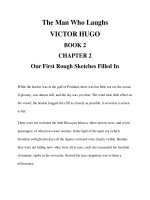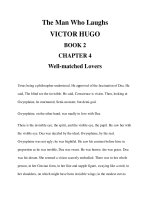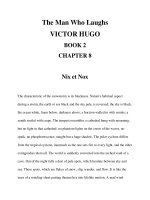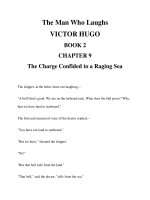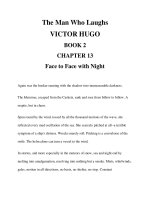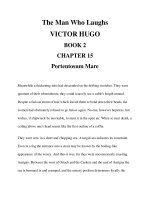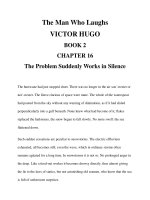Ebook Organic chemistry principles in context Part 2
Bạn đang xem bản rút gọn của tài liệu. Xem và tải ngay bản đầy đủ của tài liệu tại đây (15.28 MB, 372 trang )
Chapter 7
Fatty Acid Catabolism and the Chemistry of the Carbonyl
Group
7.1
The fatty acids in living organisms are saturated and unsaturated.
T
HE “FATS OF LIFE” BY CAROLINE POND is full of interesting
information about its subject matter including a story I remember reading
years ago in a popular textbook of organic chemistry written by two
professors at New York University, which is that the hoofs of reindeer contain a higher
proportion of unsaturated fatty acids than the upper body areas of this animal.
There are many different kinds of fatty acids, some of which are shown in Figure
7.1. These molecules, with variable length long hydrocarbon chains terminated by
carboxylic acid groups, can be broken down into two classes, saturated and unsaturated.
In fatty acids these terms take on special importance.
FIGURE 7.1
Structures and Melting Points of Various Saturated and Unsaturated
Fatty Acids
In biological systems unsaturated refers to those molecules that contain one or
more carbon-carbon multiple bonds (section 4.10, Figure 4.12), which refers in the
most part to sp2 carbon atom hybridized carbon-carbon double bonds in long chains
made up mostly of sp3 hybridized carbon atoms (section 1.4, Figure 1.2). We have
hardly noted triple bonds in our studies, that is, sp hybridized carbon, and triple bonds,
although not unknown, are rarely found in natural fatty acids, so, for now, we can
restrict our definition of unsaturated fatty acids to those containing carbon-carbon
double bonds, which, as we shall see, are essential in the role fatty acids play in living
systems.
Caroline Pond, in her book, points out that the shingle-backed lizard, which lives
in the deserts of western Australia, when fed a diet of unsaturated fatty acids likes to
spend its time in cooler places compared to being fed a diet of saturated fatty acids after
which it likes to hang around in warmer places. Other lizards apparently behave in a
similar manner. That’s pretty interesting.
As in the reindeer example mentioned above, differences in fatty acid
composition are found routinely in different parts of warm blooded animals - more
unsaturated in the appendages, more saturated in the inner body. Pond discusses the fact
that neat’s foot oil, which has been used as a lubricant since the middle ages, is derived
from the fat in a cow’s hoofs and is a liquid at room temperature while suet from the
inner parts of the body tends to be solid. Pond also points out that marine plants have far
more unsaturated fatty acids than terrestrial plants. Moreover fish have a higher
proportion of unsaturated to saturated fatty acids than land dwelling animals and fish
living in colder waters have a greater proportion of unsaturated fatty acids than fish
living in warmer waters.
Before we discover how the differences between saturated and unsaturated fats
serve life’s functions, as seen in the examples just given, let’s first understand
something about how fats are found in living organisms.
PROBLEM 7.1
Given the fact that derivatives of fatty acids are critical components of cell membranes in living entities, and that
unsaturated fatty acids melt at lower temperatures than saturated fatty acids of the same number of carbon atoms, can
you offer a biological reason for the ratios of saturated to unsaturated fatty acids found in the animals and plants noted
in this section?
PROBLEM 7.2
Do the proportions of fatty acids of different composition and degrees of unsaturation in Figure 7.3 (to be discussed
below) support your answer to Problem 7.1?
PROBLEM 7.3
Redraw the structures in Figure 7.1 showing all atoms and all lone electron pairs. Assign hybridization and geometry to
all carbon atoms that are not tetracoordinate. Assign E or Z configuration to the double bonds (section 11.2).
7.2
Fatty Acids
F
ATTY ACIDS IN VIVO ARE NOT FOUND as free carboxylic acids as
shown for the structures of several fatty acids exhibited in Figure 7.1 but
rather as esters of glycerol, that is, triglycerides. Now we will become
familiar with carboxylic acids, alcohols and esters, important functional groups (section
3.9) widely found in organic molecules. The general structure of a triglyceride is shown
in Figure 7.2 in addition to the fatty acid composition of the triglycerides found in one
vegetable oil, sesame oil. The structures of these four fatty acids are shown in Figure
7.1.
We’ve come across carboxylic acids ( sections 4.9, 5.4) and also seen a fatty acid
before in Figure 5.2. They are an important functional group (section 3.9). As noted
above, and as seen in Figure 7.1, fatty acids are structures with long hydrocarbon chains
terminated by a carboxylic acid group. The functional group in a triglyceride, an ester,
is formed by the combination of a carboxylic acid and a molecule containing hydroxyl
groups, that is, an alcohol.
Glycerol, shown in Figure 7.2, contains three hydroxyl groups and therefore can
form three ester groups with three fatty acids, which can all be the same or differ in any
way. Esters could be thought of as anhydrides (meaning loss of water) of carboxylic
acids and alcohols because the formation of an ester involves elimination of water, the
HO- group of the carboxylic acid and an H+ from the alcohol hydroxyl group. In this
chapter we’ll study the properties of esters, as they are key to both the breakdown of
fats, catabolism, and the build up of fats, anabolism (ancient Greek: ballō = I throw:
kata = downward; ana = upward).
FIGURE 7.2
Structures of a Triglyceride and Glycerol
There are two prominent biological roles of fatty acids and the esters they form
with glycerol, one structural and the other an energy source. In their structural role, the
fatty acids and their derivatives are important components of cell membranes, the
feature of every cell that acts, among other roles, as the gateway for nutrients and exit
out for expulsion of waste products of cellular metabolism. The hydrophobic nature of
fatty acids, which derives from their long hydrocarbon chains, acts to separate the
aqueous interior of the cell from the aqueous environment that surrounds the cell. It is
the requirement that the membrane be a gateway, a passageway, which causes
membranes to be composed of mixtures of saturated and unsaturated fatty acids.
As seen in Figure 7.1, unsaturated and saturated fatty acids of the same chain
length, such as, oleic acid and stearic acid, melt differently, 13° C and 69° C,
respectively. Here we find the answer to why the cell membranes in the reindeer’s hoof
contain a higher proportion of unsaturated triglycerides compared to the cell membranes
in the warmer parts of the animal’s body, and to why the cold blooded lizards prefer a
warmer climate when fed saturated fatty acids. The melting point differences between
saturated and unsaturated fats allow us to understand the proportions of the saturated to
unsaturated fatty acids in the various animals and plants in Figure 7.3.
Cell membranes composed of triglycerides of increasing proportion of
unsaturated fatty acids remain fluid, can therefore act as gateways, at lower
temperatures than membranes composed of higher proportions of saturated fatty acids.
Life exposed to lower temperatures turns to unsaturated fats to gain transport through
cell membranes.
FIGURE 7.3
Table of the Proportions of the Various Fatty Acids from Different
Animal And Plant Sources
We’ll return to the reason for the lower melting points and therefore the higher
fluidity of unsaturated compared to saturated fatty acids later in the book when we’ll
study natural rubber. (section 11.3) We’ll also discover a related phenomenon about the
differing kinds of polyethylene which the chemical industry can produce.
For now let’s focus on how triglycerides are broken down to glycerol and fatty
acids. These fatty acids then undergo catabolism to acetyl coenzyme A ( Figure 5.3),
which is an intermediate that is a source of energy and as well a biochemical building
block. All these processes involve applications of fundamental principles of organic
chemistry.
PROBLEM 7.4
Use the structures of the fatty acids in Figure 7.1 to understand the “structural code” used in Figure 7.3 and draw the
structures of the fatty acid components of the triglycerides of many of the plants and animals in the table. In your
drawing these structures do questions arise as to the proportion of each fatty acid within each triglyceride molecule?
Are you able to answer the question in this problem unequivocally? Do questions of stereochemistry also arise?
PROBLEM 7.5
In the conversion of isopentenyl diphosphate to dimethyl allyl diphosphate in sections 5.5-5.6, we came across the
concept of enantiotopic groups. Does this stereochemical designation apply to glycerol?
PROBLEM 7.6
Considering the shape around a cis versus a trans double bond and the fact that the favored conformation around the
many CH2 groups in a fatty acid chain take an anti conformation (section 1.13), and considering that in a membrane
the chains are packed close together, offer a reason (hypothesize) why cis fatty acids make membranes that are more
fluid, that is, have lower melting points, than trans fatty acids.
PROBLEM 7.7
Considering the composition of the triglycerides in sesame oil, Figure 7.2, and that there are three hydroxyl groups in
glycerol available to form esters, how many different triglyceride structures are possible?
PROBLEM 7.8
Make a list of all the functional groups you have come across in the book so far or that you are aware of from
elsewhere and draw their structures.
7.3
Saponification
I
N CHAPTER 5, SECTION 5.1 we were introduced to Michel Chevreul, the
beloved and long lived French chemist whose investigations of the water
insoluble constituents of life led to the discovery of cholesterol and several
fatty acids and also to the understanding that fatty acids occurred in nature as the esters
of glycerol, a molecule he characterized but did not discover. Glycerol was discovered
by Carl Wilhelm Scheele in the 1780s by heating fatty substances with litharge, a basic
compound of lead. He called it oelsüss and described the substance as a sweet
principle of oils and fats. Scheele’s characterization of glycerol as a sweet principle
reminded me that many years ago when I was a student, long before concerns about
toxicity and environmental hazards came to the fore, there was tradition we heard about
to taste new substances – place a trace on the tongue. Why do you think the Germans
used the word carbonsäure for carboxylic acids?
Carl Wilhelm Scheele
It is difficult to mention Scheele’s name without saying something more about this
very interesting 18th century Swedish-German chemist. Scheele, who lived a relatively
short life, from 1742 to 1786, maybe because of tasting too many chemicals, was not
someone with enviable laboratory facilities. In spite of his first laboratory being
described as a “cold and draughty wooden shed,” Scheele discovered chlorine and
oxygen and laid the foundation for photographic film in his discovery of the action of
light on silver salts. Later in his career he was given a position where he was allowed
to do research one day a week, by someone Partington called a “considerate master.”
Nevertheless, when Scheele turned his attention to what we call now organic chemistry
he discovered many organic acids including tartaric, prussic, malic, lactic, uric and
citric acids and for our current interests, a neutral molecule, as mentioned above,
glycerol. I remember when I was a young research student, my mentor, Kurt Mislow,
telling me that the drive to carry out research by some is so overpowering that they will
do it under any circumstances, not matter how difficult. I wonder if he was thinking of
Scheele. What a chemist!
When Professor James Moore of Rensselaer Polytechnic Institute read the
paragraph about Scheele he sent me the following note:
I know of this noted alchemist only because the Institute of Organic Chemistry
at the U. of Mainz is on Johann-Joachim-Becher Weg. “The chemists are a strange
class of mortals, impelled by an almost insane impulse to seek their pleasures amid
smoke and vapour, soot and flame, poisons and poverty; yet among all these evils I
seem to live so sweetly that may I die if I were to change places with the Persian
king.” Johann Joachim Becher, Physica subterranea (1667). Quoted in R. Oesper,
The Human Side of Scientists (1973), 11.
FIGURE 7.4
In Vitro Basic Hydrolysis (Saponification) of a Triglyceride
The history and production of soap is intertwined with the chemistry of the ester
functional group, which links glycerol and the fatty acids (Figure 7.2). The earliest
recorded history of the making and use of soap goes back nearly five thousand years,
although its modern widespread use in bathing is much more recent (the last two
hundred years or so). However, the fundamental chemistry for making soap has not
changed over all these years. Fats or oils from plants or animals are subjected to a basic
substance in water. The earliest process certainly involved the accidental discovery that
ashes from burning wood on mixing with animal fat and water from a cooking process
produced a substance we call soap.
The basic substance used was alkali, a mixture of soda ash, that is, Na2CO3, and
potash, K2CO3, which continued to be obtained from wood ash well into the 1700s.
However, as the need for soap increased, as people bathed more frequently, the
consequence was destruction of large swaths of European forests to get the wood to
make the ash. Some potash could be obtained by burning sea weed and this was a
source in England and Scotland with plenty of coastline but it was clear that some new
source had to be found.
In the late 1700s Nicolas Leblanc, stimulated by a monetary prize from the French
crown, a prize he was eventually denied because of the French Revolution, found a way
to transform common salt, NaCl, to soda ash. Sulfuric acid was used to convert sodium
chloride to sodium sulphate, Na2SO4, which was then reacted with limestone, CaCO3,
to produce the soap making chemical, soda ash (sodium carbonate). This history of soap
brings us back to Carl Wilhelm Scheele, who along with all his other accomplishments
noted above, was the one who discovered the essential reaction for the process in the
conversion of common salt to sodium sulphate using sulfuric acid. And, in an interesting
tale of the long and winding paths allowing Europeans to bathe in large numbers, we
find that sulfuric acid was first produced by Jabir ibn Hayyan, an Arab-Persian
alchemist who lived in the eighth century. In fact, the medieval Muslim world had
advanced methods for making soap and a recipe found on the web from a manuscript of
that time is: “ sesame oil, a sprinkle of potash, alkali and some lime - mix and boil pour into a mold and leave to set to produce a hard soap.” I guess you now know
precisely the fatty acid salts in this eighth century soap.
Nicolas Leblanc
Jabir ibn Hayyan
The chemical process, saponification, which means “soap making” from the Latin
word sapo for soap, is shown in Figure 7.4 and is an example of basic hydrolysis of an
ester. Hydrolysis is the perfect word to describe the change seen in Figure 7.4 - water,
that is, hydro, causing the lysis, from the Greek for separation. In the process, the two
parts of the ester bond are separated, the hydroxyl part from the carboxylic acid part.
The mechanism for this hydrolysis, discussed in the section to follow, is also shown in
Figure 7.4.
PROBLEM 7.9
For every structure in Figure 7.4 show all lone pairs of electrons and check on the accuracy of those already shown.
Can you justify as correct all formal charges shown in the figure?
PROBLEM 7.10
Offer an explanation of why a fatty acid does not form as effective a soap as the salt of a fatty acid, that is, with an
ionized end group, -CO2-Na+.
PROBLEM 7.11
Imagine that an alcohol of structure ROH combines with a carboxylic acid of structure R’CO2H to form a molecule
with the formula ROOCR’. Draw as many structures as you can for this formula evaluating formal charge and the
octet rule. Is there more than one possibility without formal charge that obeys the octet rule?
PROBLEM 7.12
Amides are analogs of esters formed by replacing the alcohol with an amine, such as RNH2. Propose a formula for
the amide parallel to the formula for the ester in Problem 7.11 and then answer the same question posed in Problem
7.11.
PROBLEM 7.13
For the saponification of a triglyceride, use the mechanism in Figure 7.4 to trace the oxygen atom that was originally
part of glycerol. Could you write a mechanism using a basic catalyst as in Figure 7.4 where this oxygen took another
path?
PROBLEM 7.14
In the conversion of (i) to (ii) in Figure 7.4 do you see any analogy to the chemistry of the aldehyde group in glucose
and galactose leading to ring closing of these sugars? On what structural characteristic, that is, on what common
characteristic of the functional groups involved might this analogous chemical reactivity be based?
PROBLEM 7.15
In the mechanism for saponification in Figure 7.4, curved arrows are only used in the conversion from (i) to (ii). Use
curved arrows to show the flow of electrons in all the other reactions making certain to show all electrons and formal
charges.
PROBLEM 7.16
Using leaving group concepts (section 5.3) evaluate the relative probability of reaction 2 to reaction 5 in Figure 7.4.
What does your answer reveal about the importance of reaction 3?
PROBLEM 7.17
Reaction 7 in Figure 7.4 is the only step that is shown as irreversible. Offer a reason for this irreversibility.
7.4
Similarities and Differences between Ketones and Aldehydes and
Derivatives of Carboxylic Acids: Mechanism of Saponification
I
N SECTION 3.13 and following sections of Chapter 3 we came to
understand the role of the aldehyde functional group in both the formation
of the cyclic structure of sugars and also as the source of galactosemia. The
carbonyl group, because of the weakness of the π-bond and the large electronegativity
difference between carbon and oxygen, is highly susceptible to attack at the carbon end
of the double bond by electron rich moieties, that is, molecules or portions of molecules
that are nucleophiles. We first came across the roles of nucleophiles and their electron
poor counterparts, electrophiles, in section 3.14 in our study of the chemistry of glucose
and then again in the study of the chemistry of benzene in section 6.10 and following
sections. Nucleophiles and electrophiles are terms used to describe reactants in polar
reactions.
All chemical reactions that involve interactions between positive and negative
moieties come under the general heading of polar reactions, and the hydrolysis of an
ester in converting it back to the functional groups from which it was formed (Figure
7.4), a carboxylic acid and an alcohol, is another example of this class of chemical
reactions.
The saponification mechanism is initiated (reaction 1, Figure 7.4) by attack of
hydroxide ion, HO-, on the carbonyl group of the ester, opening the π bond. We’ve seen
nucleophilic attack at carbonyl carbon before in the formation of a glucose ring by
intramolecular reaction of the OH group on carbon-5 of glucose with the aldehyde
carbon of the glucose. We’ve seen this type of chemistry again in the unfortunate
reaction of the aldehyde group of the open galactose ring with protein-bound
nucleophiles (section 3.14, Figures 3.15 and 3.16).
In fact all functional groups bearing a carbon-oxygen double bond, a carbonyl
bond, C=O, are susceptible to nucleophilic attack in this manner. But there is a big
difference for the outcome of this nucleophilic attack at carbonyl groups in aldehydes
and ketones versus those in carboxylic acids or their derivatives. The difference has to
do with the concept of leaving groups (section 5.3). Let’s take a look back at the
chemistry of the aldehyde groups in the sugars in Chapter 3 and the chemical reactions
they undergo to understand this “big difference.”
Figure 7.5 reproduces the forward reaction 5 from Figure 7.4. All chemistry of
carbonyl groups is driven forward by the opening of the π bond, which breaks to deliver
the two electrons of this bond to the electronegative oxygen and forms a new σ bond to
the incoming nucleophile. However, the consequence of this breaking of the double
bond to oxygen is formation of an intermediate in which the bond angles around carbon
have been considerably reduced from what they were for the carbonyl group, from
approximately 120° to approximately 109°, a more crowded arrangement. An exchange
of a π bond for a stronger σ bond, an energy lowering transformation, is offset by an
energy raising process in producing a more crowded bonding, the tetracoordinate
intermediate (iii) in Figure 7.5. The counterbalance means that the carbon-oxygen
double bond has a tendency to reform.
FIGURE 7.5
Importance of the Leaving Group Structure in the Hydrolysis of a
Glyceride Ester Bond
In the mechanism shown in Figure 7.5 (reproduced from step 5, Figure 7.4) the
reformation of the carbon-oxygen double bond from (iii) is shown to take a path that
forms a carbonyl bond in an entirely new structure (iv). Here we come to the “big
difference” between the carbon-oxygen double bonds in aldehydes or ketones versus
carboxylic acids and their derivatives. The option to form a new carbonyl containing
compound (step 5 leading to iv), may not be available from the tetracoordinate
intermediate formed from all carbonyl compounds. Why not?
Forming a new carbonyl-containing molecule, which is a perfectly reasonable
reaction path in the saponification mechanism shown in Figures 7.4 and 7.5, is not
reasonably possible, is in fact virtually impossible, in the chemistry of the aldehyde
group in glucose (Figure 7.6). Whereas reaction 5 from Figures 7.4 and 7.5 occurs
readily, reaction 1 in Figure 7.6 is impossible even if the final resulting product
produced by reaction 1 is a perfectly stable structure, which it is. The product of
reaction 1 (Figure 7.6) is an ester that would be formed by an intramolecular reaction
between a hydroxyl group and a carboxylic acid group within the same molecule and is
called a lactone, a functional group we will come across later in the book (section
12.12).
The difference between reaction 5, which does take place (Figures 7.4 and 7.5),
and reaction 1, which does not take place (Figure 7.6) arises from the leaving groups
(section 5.3) involved. Reaction 5 in reforming the carbonyl group of the carboxylic
acid (iv) forces out one of the hydroxyl groups of glycerol. Reaction 1 (Figure 7.6) in
reforming the carbonyl group and therefore leading to a cyclic ester (a lactone) (b)
would have to force out a hydride ion, H:-.
As discussed in Chapter 4 (sections 4.9 and 4.11) the conjugate base of a
Brønsted-Lowry strong acid must be a stable entity, such as Cl - from hydrochloric acid,
or H2PO4- from phosphoric acid or H2O from H3O+, the hydronium ion. The latter ion is
particularly relevant in the situation for reaction 5 in Figures 7.4 and 7.5. The glycerol
hydroxyl group expelled in reaction 5 is the conjugate base of the protonated hydroxyl
group shown in (iii), an analogously strong acid to the hydronium ion. Reaction 5 is
driven forward by the ejection from the tetracoordinate intermediate, iii, of an excellent
leaving group, the conjugate base of ROH2+.
If reaction 1 took place, it would eject from the tetracoordinate intermediate (a,
Figure 7.6) a hydride ion, H:-, which is the conjugate base of H-H an impossibly weak
acid. A hydride ion, H: -, is therefore an unlikely leaving group. Because of the unlikely
leaving group reaction 1 in Figure 7.6 would not take place.
FIGURE 7.6
Intramolecular nucleophilic attack shown from the open chain of
glucose leads to addition rather than substitution because of an
extremely poor leaving group.
We can extend the discussion of the difference between the chemistry of (iii) in
Figures 7.4 and 7.5 and that of (a) in Figure 7.6 to a general consequence of the four
coordinate intermediates formed from aldehydes and ketones after nucleophilic attack.
In these carbonyl functional groups, the flanking atoms to the carbonyl carbon are
always carbon or hydrogen therefore requiring formation of a carbanion, R3C:- or H:- to
be expelled to reform the carbonyl group from a four-coordinate intermediate. Figure
7.7 exhibits these ideas for a typical ketone, acetone, and a typical aldehyde,
acetaldehyde with nucleophilic attack by methoxide ion (H3CO:-).
Now you might ask: If nucleophilic attack at the carbonyl carbon atom of
aldehydes and ketones can take place and if the carbonyl group can not reform, as we’ve
just learned, then what happens after this nucleophilic attack? You can answer your own
question by looking at Chapter 3 at the ring closing reactions of the sugars and you’ll be
finding other examples later in the book (section 12.7).
In the special circumstances serving life’s needs, the rules laid down above find
an exception, which makes sense with regard to the leaving group ideas discussed
above – in fact the exception, as they say, that proves the rule. A carbanion can be
expelled (not reaction 1 Figure 7.7) from a four coordinate intermediate arising from an
attack at carbonyl carbon if the negative charge at carbon is stabilized. And, in fact, an
essential step in the biochemical process by which fatty acids are broken down into two
carbon pieces, catabolism, which we’ll look into in this chapter, and the catabolism of
sugars to be studied in the chapter to follow, will yield examples of this exception.
FIGURE 7.7
Nucleophilic attack at carbonyl carbon of ketones and aldehydes is
shown not to lead to substitution because of extremely poor leaving
groups.
PROBLEM 7.18
Can you offer two reasons why aldehyde carbonyl groups are more susceptible to nucleophilic attack than ketone
carbonyl groups? Now apply your ideas to predict the relative propensities to nucleophilic attack at the ketone carbonyl
group by hydroxide ion on methyl ethyl ketone versus hydroxide ion on methyl tertiary butyl ketone.
PROBLEM 7.19
“Knockout drops” is the name for a drug that causes rapid unconsciousness in the victim. The formula is
Cl3CCH(OH)2, chloral hydrate. Offer a structure for chloral hydrate and suggest why trichloroacetaldehyde, Cl3CCH=O, adds water to form chloral hydrate, which has little driving force to return to the carbon-oxygen double bond.
PROBLEM 7.20
An unusual reaction takes place between trichloroacetaldehyde and sodium hydroxide in water: H(C=O)CCl3 + OHH(C=O)O- + HCCl3. If one of the chlorine atoms in the starting aldehyde is replaced by hydrogen atoms the reaction
does not take place under the same conditions. Here’s an important piece of information. Chloroform, HCCl3, is a
moderately weak acid because of the stability of the trichloromethyl anion, Cl3C:-. Offer an explanation for why this
reaction is an exception to the general rule for ketones.
PROBLEM 7.21
From your answer to problem 7.19 can you predict something about the properties of hexafluoroacetone (F3C)2C=O,
in water?
PROBLEM 7.22
Draw the structure of the ester that would be formed from the reaction of phenol, C6H5OH (a benzene ring with one
hydrogen replaced by OH) with acetic acid, H3C-CO2H and then another ester that would be formed by reaction of
methanol with acetic acid. Based on the fact that phenol is a moderately weak acid (pKa about 10), while methanol is
a far weaker acid, offer an explanation for the higher reactivity for basic hydrolysis for the phenyl over the methyl
ester. Show a possible mechanism for this hydrolysis based on the information in Figure 7.4.
PROBLEM 7.23
Suggest a carbon-carbon bond breaking reaction to reform the carbonyl group from the intermediate in Figure 7.6,
which is just as improbable as the reaction shown not to take place.
7.5
Hydrolysis of the Triglyceride Ester Bonds: Enzyme Catalyzed Path
S FOR ALL BIOCHEMICAL REACTIONS, hydrolysis of triglycerides is
enzymatically catalyzed. In human beings this transformation takes place
with an enzyme called pancreatic lipase. This enzyme has been very well studied,
A
so that the mechanism by which the three amino acids that find themselves properly
placed to carry out the hydrolysis has been determined. As understood from sections 5.5
and 5.9 it is the complex folding properties of the protein, which brings these three
amino acids together in a “pocket.” This pocket, that is, the active site, is designed to
hold the molecule that will undergo chemical change.
The necessity for protein folding is demonstrated again for human pancreatic
lipase by the very different positions along the lipase protein chain for these three amino
acids: serine, the 152nd amino acid; aspartic acid, the 176th amino acid; and histidine,
263rd, which are all along the chain designated from the N-terminus of the protein. The
protein contains 449 amino acids linked end to end in its structure. The folding of the
lipase is shown in Figure 7.8 and even if this is not the place to understand all the
twists and turns in the structure shown in this figure, the structure certainly is, as were
Figures 5.8 and 5.15, marvels to observe – to observe what nature has put to work for
catalytic purposes.
It is interesting to see how the protein chain begins and ends. The sequence of
amino acids begins with alanine, followed by aspartic acid, and then by glutamine and
so on until the last three amino acids in the sequence, lysine, serine and finally, glycine.
By convention, the beginning of the protein is designated as the end of the chain with a
free amino group, NH2, or some derivative of an amino group, while the end of the
chain is terminated with a free carboxylic acid group, CO2H, or some derivative of that
group. The structures of the three amino acids (which we have drawn by hand) at each
end of the protein chain are shown in Figure 7.9, although not shown in detail for their
conformational states or their states of ionization. Depending on pH, the various amino
and carboxylic acid groups may appear as NH3+ or CO2- or not ionized, NH2 or CO2H,
respectively.
FIGURE 7.8
Representation of the Folded State of Human Pancreatic Lipase, the
Enzyme that Catalyzes the Hydrolysis of the Ester Bonds of
Triglycerides
Figure 7.10 portrays a representation of the three amino acids that constitute the
active site of the protein, that is, the amino acids participating in the hydrolysis of the
ester bond between the glycerol hydroxyl group and the fatty acid carboxylic acid
group. From left to right, there is the conjugate base of aspartic acid, histidine and
serine. Figure 7.10 also includes the first steps of the mechanism of the hydrolysis.
In this first step, 1, of the enzyme-catalyzed mechanism shown in Figure 7.10, we
find the familiar curved arrows designating the movement of electrons and discover that
the reaction path involves a coordinated process – several transfers of electrons and
atoms take place in concert. The result of this cascade of reactions is that the nitrogen
containing histidine is acidic enough at one of the nitrogen atoms to donate a proton to
the aspartate and also basic enough at the other nitrogen atom to remove the proton from
the hydroxyl group of the serine residue. These proton transfers produce therefore, the
conjugate base of serine, which is capable of nucleophilic attack at the carbonyl carbon
of the ester group.
FIGURE 7.9
Three Amino Acids, Drawn by Hand, at Each of the Termini of the
443 Amino Acid Enzyme Shown In Figure 7.8
FIGURE 7.10
Enzyme catalyzed mechanism involving the three amino acids in the
active site acting to transfer the fatty acid from the glyceride bond to
an ester with a serine unit on the protein chain.
The next step, 2, accomplishes the same result as reaction 1 in Figure 7.4, the π
bond forming the carbonyl group is broken and a four-coordinate intermediate is
formed.
Step 3 picks up the mechanism from the tetracoordinate intermediate where we
see a demonstration of the beautiful advantage of the precise geometry arising from the
precisely folded protein structure. In Figure 7.4, showing the in vitro hydrolysis of an
ester, that is, saponification, most of the reactions were reversible. In the
tetracoordinate intermediate shown in Figure 7.10, reformation of the carbonyl group
could occur, in principle, via ejection of the serine oxygen atom, thereby reversing the
prior step, 2, or, on the other hand, by ejection of the glycerol oxygen atom, which
advances the hydrolysis.
As shown in step 3, the precise transfer of a proton from the histidine nitrogen
atom to the oxygen atom of the glycerol moiety, a movement of atoms that arises from
the precise folding of the protein, forces the reaction path to advance the hydrolysis.
This kind of detailed control of the pathways of chemical reactions, seen routinely in
enzymes and exemplified in Figure 7.10, is the envy of the most brilliant and successful
synthetic organic chemists who find such control generally inaccessible to reactions in
laboratories and in industrial processes. The precise control that goes on in the routine
chemical processes within our bodies can not be easily reproduced under our control.
In Figure 7.10 in steps 1, 2 and 3, we’ve seen the ester bond between the fatty
acid and the glycerol hydroxyl group, replaced by a new ester bond arising from the
combination of the fatty acid with the hydroxyl group of the serine amino acid residue
located at the 152nd position from the nitrogen end of the enzyme. Organic chemists,
appropriately, call this kind of reaction a transesterification.
FIGURE 7.11
Enzyme catalyzed mechanism involving the same amino acids as in
figure 7.10, now converting the ester bond of the fatty acid with
serine to the free fatty carboxylic acid.
The fatty acid moiety is now buried deep within the lipase protein structure.
Obviously, something else has to happen. The fatty acid has to be released from the
protein and the protein has to be released to work on another triglyceride ester bond. As
shown in Figure 7.11, a molecule of water comes to the rescue. And this water
molecule does not originate from a pool of water. Again following the precision theme
of the working of the enzyme, a single water molecule is let in to the reaction site and
oriented in such a manner to do the necessary job.
Just as one of the nitrogen atoms of the histidine took a proton from the serine
hydroxyl group in initiating the reaction in Figure 7.10 (step 1), so the histidine in
Figure 7.11 takes a proton from a water molecule allowing nucleophilic attack from the
resulting hydroxide ion, HO-, to produce a tetracoordinate intermediate (step 4).
The step to follow, again demonstrates the specific reactivity arising from precise
geometric placement of the reactive groups arising from the folding of the protein shown
in Figure 7.8. In step 5, if the hydrogen bound to nitrogen in histidine were able to reach
the OH group, step 4 could be reversed. There is no intrinsic chemical reason other than
a spatial relationship, for this nitrogen bound proton to add to the serine oxygen rather
than the oxygen of the OH group. The spatial relationship, as just noted, does not allow
approach of the proton to the OH group, but only to the serine oxygen. What follows
from the delivery of the proton to the serine oxygen atom is that the reactive process
proceeds as intended to release the fatty acid and return the enzyme active site to take
another turn at the next glyceride ester bond presented to it. And this presentation, as
you expect, will present the carbonyl group of the ester in precisely the correct spatial
relationship to take step 1 (Figure 7.10) over again.
In this mechanistic portrayal of the working of the human lipase we see the
essential characteristics of all enzyme-catalyzed reactions – reactive amino-acid-based
groupings placed in precise spatial relationships around a substrate to accomplish the
intended chemical process.
PROBLEM 7.24
Assign absolute configurations, (R) or (S), to the six amino acids at the ends of the lipase chain shown in Figure 7.9.
PROBLEM 7.25
Compare the steps in the saponification mechanism in Figure 7.4 with the parallel steps in Figures 7.10 and 7.11
showing where the action of the enzyme blocks a reaction that would reverse the overall hydrolysis of the ester bond.
PROBLEM 7.26
In the enzyme-catalyzed hydrolysis of the glyceride ester bond shown in Figures 7.10 and 7.11, a histidine unit on the
protein chains plays a central role as both a Brønsted-Lowry base and an acid. Identify the reactions that justify this
statement.
PROBLEM 7.27
In each reaction step in Figures 7.10 and 7.11 (1-5) identify all moieties that are acting as acids or bases and specify
which role is played.
PROBLEM 7.28
Is the ring in the histidine unit in Figures 7.10 and 7.11 aromatic? If so, identify the electrons contributing to this
aromaticity and determine if any reactions interfere with the aromatic stabilization.
PROBLEM 7.29
Consider the structures of the amino acids that are pointed to in Figures 7.9-7.11 when removed from the chain by
hydrolysis of the linking amide bond. Identify all functional groups that could act as Brønsted-Lowry acids or bases.
Now imagine glycine, lysine and glutamic acid dissolved in water. As you change the solution from acidic to basic what
changes would you expect in the amino acid?
7.6
Biochemical Conversion of Fatty Acids to their Thioesters with
Coenzyme A: The Key Role of Leaving Groups
T
HERE IS A GREAT DEAL of complex, very interesting biochemistry
involved in the fate of a fatty acid. But the essential organic chemistry,
which is our focus, takes the fatty acid to form what is called a thioester,
which is the stepping-off point before breaking up each fatty acid into many two carbon
pieces, for example, nine molecules of acetyl coenzyme A from the eighteen carbon
atoms of stearic acid. Let’s look back to Chapter 5 (Figure 5.3) where we saw the
structure of this important biological molecule, acetyl coenzyme A.
The first prerequisite step for breaking up the fatty acid is conversion to a
thioester. Acetyl coenzyme A is also a thioester, that of acetic acid. An ester and a
thioester differ by replacing an oxygen atom in an ester with a sulfur atom in a thioester.
Taking account of the atoms, an ester is the combination of a carboxylic acid with a
hydroxyl containing molecule, ROH, the focus of this chapter so far, while a thioester is
the combination of a carboxylic acid with a thiol, RSH. Coenzyme A is a thiol.
The prerequisite for the breakdown of a fatty acid to yield life’s energy and
building blocks is for the fatty acid to be converted to a thioester of coenzyme A as
shown in Figure 7.12. The steps in this conversion are, as for all biological chemical
reactions, enzyme-catalyzed , but here we will focus on the chemical steps and the
coenzymes involved, which reveal a great deal about how biological mechanisms use
organic chemistry principles.
FIGURE 7.12

